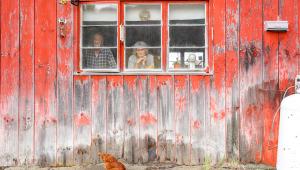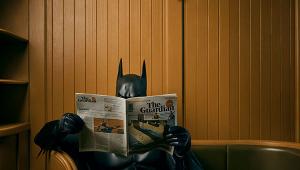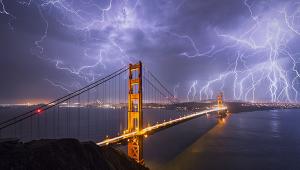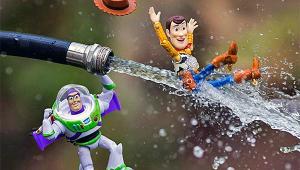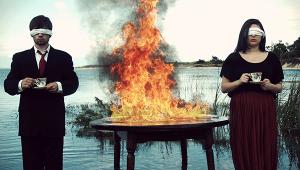Pro's Choice: Michael Becker’s Celebrity Portraits: Time Is Limited, So Focus Is On Lighting And Rapport
When it comes to portraiture, celebrities are like everyone else, except that for editorial shoots your time with them is very limited. “I’ve literally had as little as 3 minutes and as much as 20 minutes with an individual,” Los Angeles-based photographer Michael Becker observes.

Michael Becker shot this portrait of Ellen DeGeneres on the set of her talk show. He set up a dark blue seamless paper backdrop off to the side of the stage, with a Profoto ringlight mounted to the camera as key and a grid hitting the backdrop to create that circle of light. “She was in the middle of taping her show, so we would get her between segments for short periods. We were shooting tethered to the computer and, as the images came up on screen, crew members nearby responded enthusiastically to her animated poses, and she would feed off that energy.” DeGeneres stood very close to the camera, with Becker employing a 24-70mm zoom set to 35mm.
Photo credit: Michael Becker/© FOX
So, how does Becker set up his lighting, given these constraints? Simple enough: “Typically, one of the assistants will stand in. We’ll look at the space and existing light and add whatever is necessary. With editorial, where possible I prefer to go with a natural look.”
The Road To Celebrity Portraiture
Michael Becker began his professional career out of college, songwriting and producing music for film, television, and commercials. But photography always pulled at his heartstrings, back from the day his grandfather, a studio photographer, gave him an old Rolleiflex. “I was beginning to tire of the business side of music and returned to photography and that Rolleiflex after moving back to New York. It took a few more years until I finally decided this was the direction my life would take. At that time, I also started experimenting with Polaroid 665 film and working with pinhole photography.” By now, he was again living in and working out of Los Angeles.

A loft set was custom-built, complete with faux window “to add a natural vibe,” for this portrait of “American Idol” contestant Michael Johns. “We took white foamcore and created some V-shaped flats (bounce cards) outside the window. Then we used a Profoto strobe from about 10 feet back and aimed it through the window to create that pattern on the wall, adding some tree branches in the light path. Blasting a couple of lights into the foamcore gave it the appearance of a sunlit window.” A large Elinchrom Octa standing 5 feet back from the edge of the set added a subtle fill. Becker also employed one of his custom-made Fresnels with a grid as an edge light on Johns. Another light came in over the piano, with a full CTO orange gel giving it the feeling of an area light.
Photo credit: Michael Becker/© FOX
As luck would have it, around this time Becker met his future wife, who was a TV producer. Her network, ABC, was looking for a freelance public relations photographer and she recommended him for the job. At the time, he owned a Nikon D70. The success of that assignment quickly led to other assignments with the network and before he knew it, Becker was traveling around the country shooting stills on reality shows and soap operas. That gave him the material he needed for a promotional mailer and his website, which soon led to photo assignments to photograph celebrities for other networks, namely FOX and FX.

“I always kept an old Polaroid 250 loaded with a pack of film inside my car, and, as I was driving by, this scene caught my eye. Then, as I sometimes do with Type 665 Polaroid film, after peeling it apart, I threw it up on the dashboard to let it bake in the California sun for several days, so that it became solarized and crackly.” The print was then scanned, with its original borders, and given a slightly warmer tone.
© Michael Becker
“At one point, I did switch to Canon at the urging of my clients, but eventually switched back to Nikon,” choosing the D3 and D700. “I now work with two D800E bodies.” His lenses of choice include the Nikkor 14-24mm f/2.8, 24-70mm f/2.8, and 70-200mm f/2.8, with the last two being his go-to lenses. “Because of how fast my world moves, I’m always on zooms. But I also recently added the 24mm f/1.4 and 85mm f/1.4 for my editorial work.” Becker converts Raw files with Phase One’s Capture One Pro 7.
Becker mostly shoots handheld, but when the need arises he employs a Gitzo carbon-fiber tripod fitted with a Really Right Stuff leveling base and Wimberley gimbal head. “The gimbal head lets me move at a speed I’m comfortable with. I need to be able to follow a moving subject and still be stabilized.” He adds: “In the studio, I’ve started relying more on the tripod because I like the way it has slowed me down. It gives me an opportunity to interact more with the subject and be more deliberate about the shot I’m after. I tend to move around a lot when working handheld, which is appropriate for some jobs, but I’ve really enjoyed shooting at a calmer pace lately.”

“We grabbed this shot of guitarist/musician Stevie Gurr just as the sun set. We were shooting this for an album he was cutting with his band Emith.” The location is Llano, California, just south of the Mojave Desert. “We had been using a large Elinchrom Octa as an accent light, but the natural lighting was so amazing, we turned it off.” Becker desaturated the backdrop for effect.
© Michael Becker
Approach To Lighting
“Early on I shot black and white entirely,” Becker recalls. “As inspiration, I turned to the work of Hollywood glamour photographer George Hurrell. I loved the simplicity of his lighting and the way it still managed to give dimension and depth to the actors he portrayed.”
As a fledgling photographer on a budget, Becker bought a Lowel ViP Pro-light with barn doors. “I employed the barn doors to create a sliver of light on the subject’s face for dramatic effect. Eventually I got a second light that I positioned behind the subject as a hairlight, but I still favored working with a single light.”
Shooting on a TV set was a different story. There he had to work with the lights already established by the DP (Director of Photography). “It was my job to capture the mood of the show through the existing set lighting. Your job as a set still photographer is to blend in, unnoticed, while not being in the eye line of the actors or getting in the crew’s way. One of the best things I learned from being a set photographer is that it’s all about controlling light to create a certain mood and texture. And just as important, keeping the light away from what you don’t want lit.”
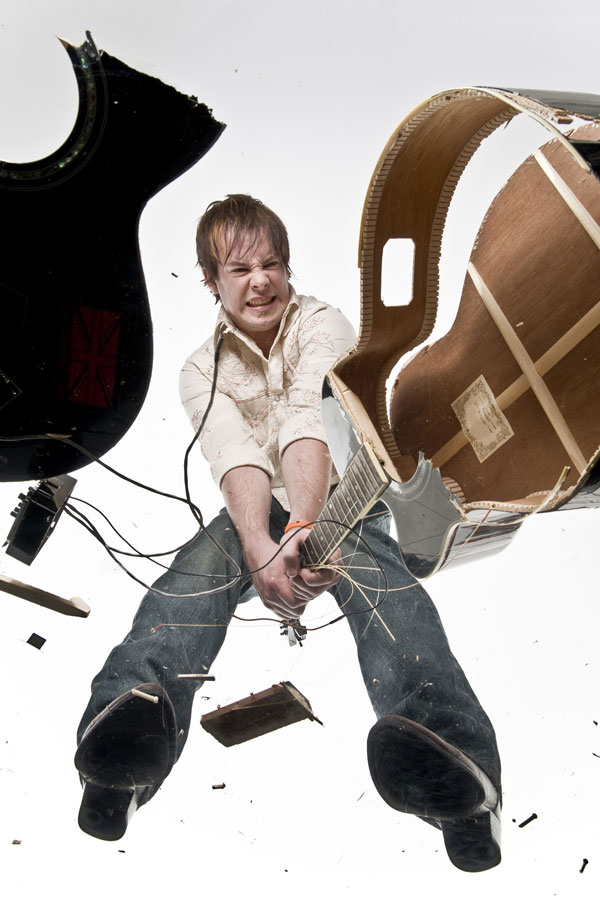
The idea was for Becker to shoot upward through Plexiglas, and “American Idol” singer/songwriter David Cook decided that smashing his guitar would fit right into this concept. A set was built made of 3/4” Plexi about 4 by 6 feet in size, supported on a large tubular frame. Draped behind and over that was a wide plastic sheet serving as the backdrop (plastic sheeting because seamless wouldn’t cover the area for this wide-angle shot). They also had to cover the entire floor with black Duvateen to prevent reflections. “There were several lights coming from softboxes behind me, and a beauty dish with a grid held by an assistant to the side of my head.” It took several tries to smash the guitar to bits, with the artist posing for the final shot surrounded by the smashed instrument.
Photo credit: Michael Becker/© FOX
The Transition To Strobe
“I soon realized that my interest was in shooting portraiture, and that meant learning a different style of lighting. Initially I bought an inexpensive strobe kit. But I quickly found these lights didn’t suit my needs and decided it was time to make a serious investment.” That led to Profoto. He now owns two Acute packs—2400 ws and 1200 ws—with three heads. He often favors the smaller pack “because I frequently like to shoot wide open, at low power, with two heads. It also helps if you need to match existing low-light conditions.” He also has a battery-powered Pro-7b pack with two heads, which is ideal for location work without AC. And to round out his lighting, he added a pair of Profoto 600 ws monolights.
As for shaping the light, “I use umbrellas to light backdrops,” Becker points out. He also favors the Photek Softlighter as a key light. “I use it because it lends a distinctive look to the picture and sets up fast.” Another favorite is the large Elinchrom Octa as key light, or as fill when combined with a beauty dish or an Elinchrom 39” Rotalux Deep Octa. Becker also retrofitted some 7” reflectors with Fresnel lenses. “I use them as a rim light. I’m also a big fan of using a strip light with a grid from behind as an edge light.”
Becker uses a Sunbounce
Sun-Swatter to diffuse outdoor sunlight, along with white or gold Lastolite collapsible reflectors. “Outdoors, the gold is difficult to use—you have to feather in a bit of the edge; otherwise you blind the subject. The solid gold works great if it’s cloudy outside because it will add a bit of shape, color, and kick. If I’m outside with plenty of sunlight and getting the color I need, I’ll use the white reflector. It’s soft; you put it right where you need it; and you don’t have to worry about blinding the model. Plus the color can always be warmed up later when processing the image.”
Returning to the subject of working with famous people, Becker concludes: “Your time with a celebrity is so brief that it’s important to establish trust and to let them know that their vision for the shoot is your goal. Even though the shoot will often have a prepared concept or look, be willing to adapt so that it fits their approval. The best shot in the world will never be seen if they don’t approve it.”
To see more of Michael Becker’s work, visit www.michaelbeckerphotography.com.
- Log in or register to post comments



